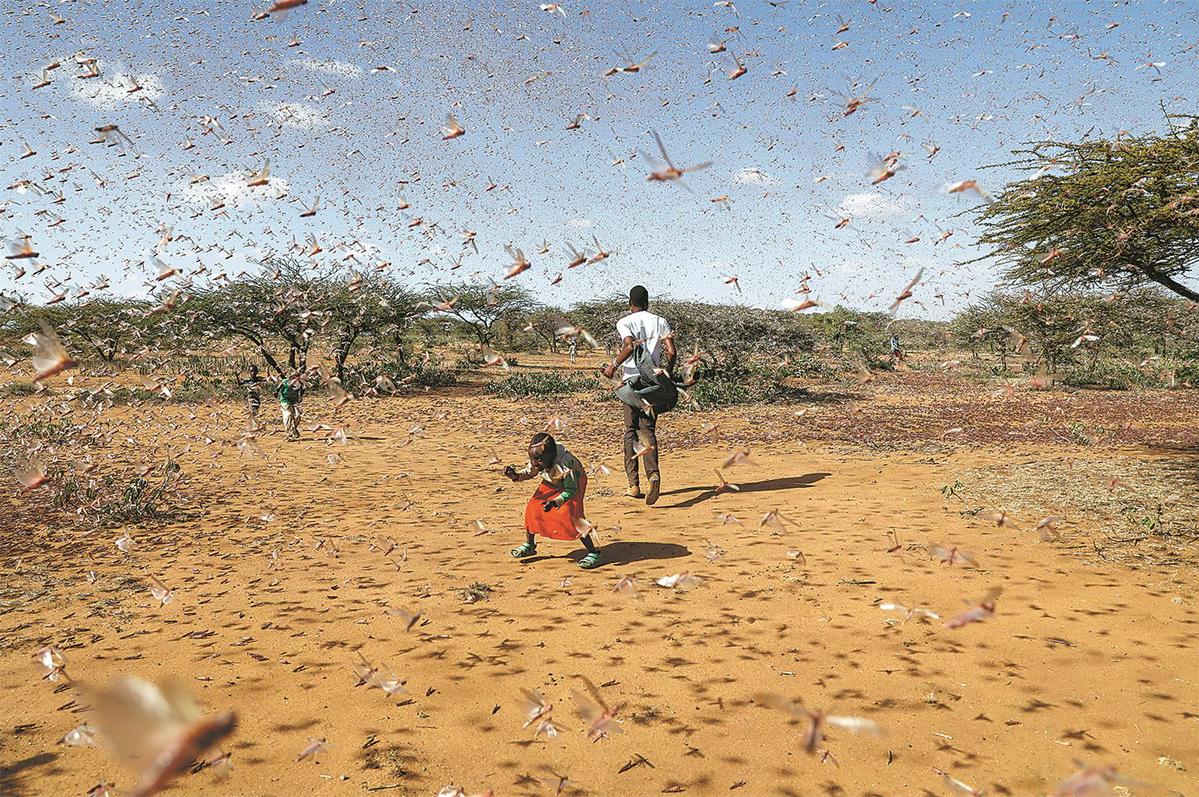Technology can play key role in leading fight against devastating locust swarms
By Barry He | China Daily Global | Updated: 2024-05-17 09:29

Locust swarms are a devastating natural phenomenon in the developing world. Having plagued civilization for thousands of years, climate change along with the moisture and shelter provided by human infrastructure mean that a single swarm is capable of demolishing food sources for tens of thousands of people in less than 24 hours.
Left unchecked, they not only destroy people's livelihoods and crops but also wild plants, causing havoc to local ecosystems.
New technology is being used to combat this threat to global food security. Data analysis is employed to track swarm movements and recent advancements in drones and pesticides are also utilized to tackle them.
A multidisciplinary approach is needed. Some natural disasters, such as floods and earthquakes, are often straightforward in their damage mechanism; water flows can be tracked and earthquakes often give tremors.
But locust swarms are often overlooked and their unpredictability makes them the most dangerous pest in the world, as climate change alters their path of destruction.
The desert locust can form swarms which grow exponentially fast. A population of locusts can multiply by 20 every few months, meaning billions of unstoppable insects can descend upon food storage sites and decimate them.
An outbreak on the Arabian peninsula in 2018, originating in Saudi Arabia, Yemen and Oman, reached as far as Kenya and the Democratic Republic of Congo. The plague of locusts lasted for more than three years before fading away, but having had an impact greater than any flood or earthquake could manage.
The advent of drone technology is helping scientists monitor and prevent swarm outbreaks. Locusts tend to lay eggs in soil which has a certain level of moisture, along with surrounding foliage for their young to feed off as they grow.
Drones can help researchers cover vast tracts of ground in order to identify suspicious or at-risk areas, which may harbor hatchlings. These drones can differ slightly from the rotor blade-based hobbyist drones and instead have fixed wings, like an aeroplane, improving range and battery efficiency to cover expansive desert areas.
Analyzing data sets of satellite maps beforehand can help identify these areas efficiently, in order to send recon drones on the most productive routes.
Once an area has been identified, drones can also be used to spray pesticides over swarms, with the optimal height being around 10 meters. Higher than this risks the wind dissipating the spray, often resulting in wastage.
The pesticides themselves, on the other hand, have room for improvement. Traditionally, nerve agent chemicals were used which quickly culled swarms of locusts effectively. Unfortunately, these chemicals' effects were not limited to locusts, with people living in the surrounding area also falling ill and suffering as a consequence.
In many countries, desert locusts have traditionally been seen as an alternative food source, providing a healthy source of protein for communities. However, official advice now discourages this practice due to the prevalence of toxic pesticides.
Such chemicals are banned in the European Union, additionally because of concerns over nerve agent pesticides affecting honey bee populations and other local fauna.
Increasingly, fungal-based pesticides are being adopted, with such formulations demonstrating a kill rate of 70-80 percent after two weeks, with negligible consequences for other animals and plants in the local area.
Unlike chemical-based pesticides, locusts are infected by fungal pesticides, causing them to move slowly, making them more likely to get picked off by natural predators, and then eventually dying from disease.
They can also spread the infection to healthy locusts, increasing its effectiveness. Fungal pesticides can also survive and lay dormant in the environment, infecting healthy locusts later.
All these solutions, unfortunately, require funding and continued ingenuity from researchers. It is still a grim reality that locust swarms tend to have the biggest impact upon areas of the world where hardship is already rife.
Conflict zones in developing countries hamper the effort of scientists and aid workers when their safety is at risk, and a lack of resources from local authorities can result in ineffective attempts to prevent locust swarms from causing damage.
























